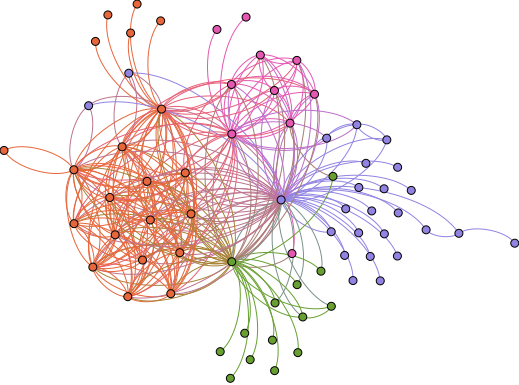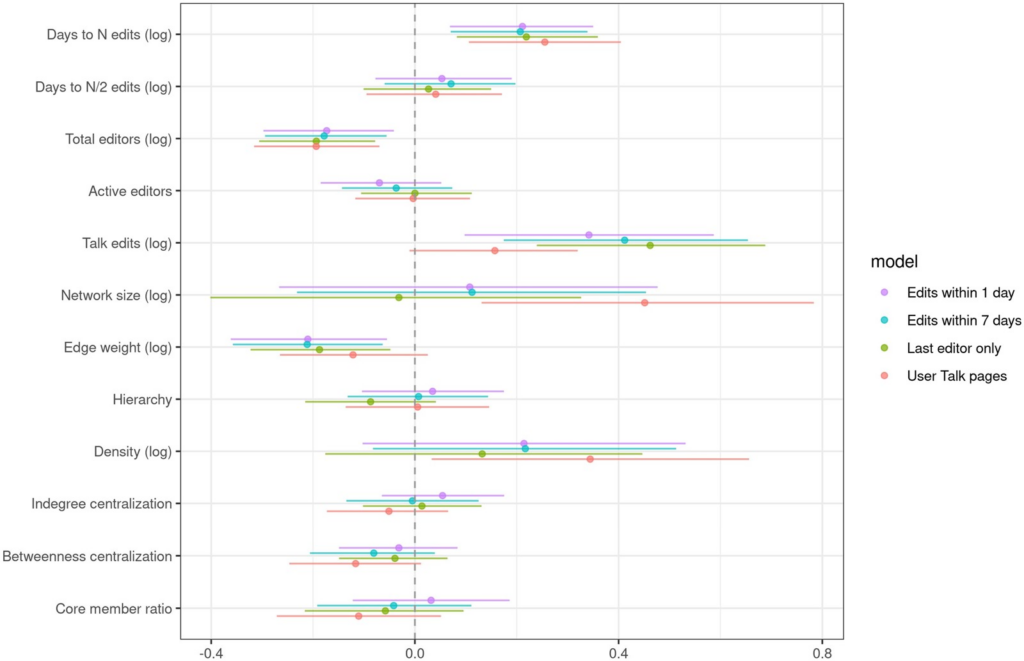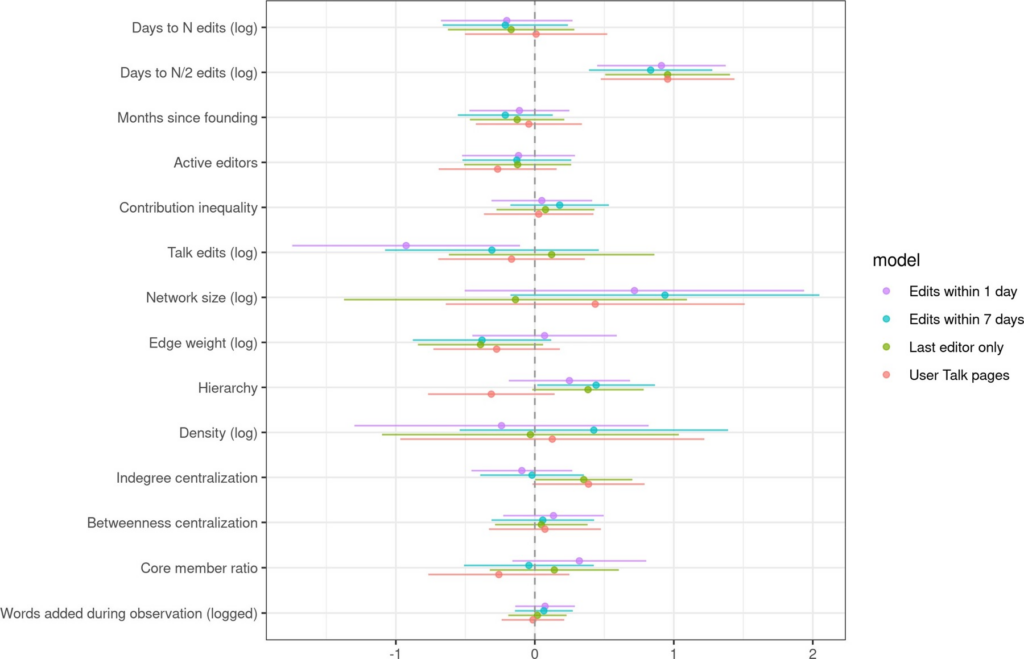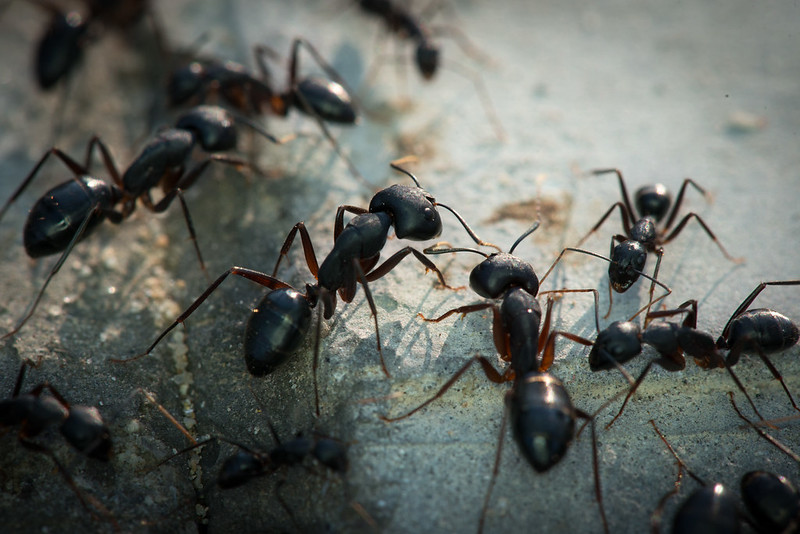A new paper that our that our group has published seeks to test whether the kind of communication patterns associated with successful offline teams also predict success in online collaborative settings. Surprisingly, we find that it does not. In the rest of this blog post, we summarize that research and unpack that result.
Many of us have been part of a work team where everyone clicked. Everyone liked and respected each other, maybe you even hung out together outside of work. In a team like that, when someone asks you to cover a shift, or asks you to stay late to help them finish a project, you do it.
This anecdotal experience that many of us have is borne out by research. When members of work groups in corporate settings feel integrated into a group, and particularly when their identity is connected to their group membership, they are more willing to contribute to the group’s goals. Integrative groups (where there isn’t a strong hierarchy and where very few people are on the periphery) are also able to communicate and coordinate their work better.
One way to measure whether a group is “integrative” is to look at the group’s conversation networks, as shown in the figure below. Groups where few people are on the periphery (like on the left) usually perform better along a number of dimensions, such as creativity and productivity.

In our new paper, we set out to look for evidence that early online wiki communities at Fandom.com work the same way as work groups. When communities are getting started, there are lots of reasons to think that they would also benefit from integrative networks. Their members typically don’t know each other and communicate mostly via text—conditions that should make building a shared identity tough. In addition, they are volunteers who can easily leave at any time. The research on work groups made us think that integrative social structures would be especially important in making new wikis successful.

In order to measure the social structure of these communities, we created communication networks for almost 1,000 wikis for the talk that happened during their firs 700 main page edits. Connections between people were based on who talked to whom on Talk pages. These are wiki pages connected to each page and each registered user on a wiki. We connected users who talked to each other at least a few times on the same talk pages, and looked at whether how integrative a communication network was predicted 1) how much people contributed and 2) how long a wiki remained active.
Surprisingly, we found that no matter how we measured communication networks, and no matter how we measured success, integrative network measures were not good at predicting that a wiki would survive or be productive. While a few of our control variables helped to predict productivity and survival, none of the network measures (nor all of them taken together) helped much to predict either of our success measures, as shown in Figures 5 and 6 from the paper.


So, what is going on here?
We have a few possible explanations for why communication network structures don’t seem to matter. One is that group identity for wiki members may not be influenced much by network structure. In a work group, it can be painfully obvious if you are on the periphery and not included in conversations or activities. Even though wiki conversations are technically all public and visible, in practice it’s very easy for group members to be unaware of conversations happening in other parts of the site. This idea is supported by research led by Sohyeon Hwang, which showed that people can build identity in an online community even without personal relationships.
Another complementary explanation for how groups coordinate work without integrative communication networks is that wiki software helps to organize what needs to be done without explicit communication. Much of this happens just because the central artifact of the community—the wiki—is continuously updated, so it is (relatively) clear what has been done and what needs to be done. In addition, there are opportunities for stigmergy. Stigmergy occurs when actors modifying the environment as a way of communicating. Then, others make decisions based on observing the environment. The canonical example is ants who leave pheremone trails for other ants to find and follow.

In wikis, this can be accomplished in a few ways. For example, contributors can create a link to a page that doesn’t yet exist. By default, these show up as red links, suggesting to others that a page needs to be created.
A final possible explanation for our results is based on how easy it is to join and leave online communities. It may be that integrative structures are so important because they help groups to overcome and navigate conflicts; in online communities contributors may be more likely to simply disengage instead of trying to resolve a conflict.
As we conclude in the paper:
Why do communication networks—important predictors of group performance outcomes across diverse domains—not predict productivity or survival in peer production? Our findings suggest that the relationship of communication structure to effective collaboration and organization is not universal but contingent. While all groups require coordination and undergo social influence, groups composed of different types of people or working in different technological contexts may have different communicative needs. Wikis provide a context where coordination via stigmergy may suffice and where the role of cheap exit as well as the difficulty of group-level conversation may lead to consensus-by-attrition.
We hope that others will help us to study some of these mechanisms more directly, and look forward to talking more with researchers and others interested in how and why online groups succeed.
The full citation for the paper is: Foote, Jeremy, Aaron Shaw, and Benjamin Mako Hill. 2023. “Communication Networks Do Not Predict Success in Attempts at Peer Production.” Journal of Computer-Mediated Communication 28 (3): zmad002. https://doi.org/10.1093/jcmc/zmad002.
We have also released replication materials for the paper, including all the data and code used to conduct the analyses.